Galway: Difference between revisions
m clean up |
|||
| Line 102: | Line 102: | ||
Amongst the city's limestone buildings is the Hotel Meyrick, originally the Railway Hotel and then the Great Southern Hotel, built by the Great Southern Railway Company in 1845.<ref name="Hotel Meyrick Website">{{cite web|url=http://www.greatsouthernhotelgalway.com/ |title=Hotel Meyrick – About |publisher=Greatsouthernhotelgalway.com |accessdate=12 August 2010}}</ref> Sitting at the southern perimeter of Eyre Square, it is the City's oldest hotel still in operation. | Amongst the city's limestone buildings is the Hotel Meyrick, originally the Railway Hotel and then the Great Southern Hotel, built by the Great Southern Railway Company in 1845.<ref name="Hotel Meyrick Website">{{cite web|url=http://www.greatsouthernhotelgalway.com/ |title=Hotel Meyrick – About |publisher=Greatsouthernhotelgalway.com |accessdate=12 August 2010}}</ref> Sitting at the southern perimeter of Eyre Square, it is the City's oldest hotel still in operation. | ||
The Spanish Arch, in the | The Spanish Arch, in the south-west of the city, was built in the 1580s as an extension to the city walls, a part of which can be seen in the Corbett Court shopping centre. | ||
In front of the Spanish Arch and opposite Jury's Hotel is a monument (see photograph at bottom of this article) to Christopher Columbus. It was presented to Galway by the city of Genoa in 1992 to commemorate both the 500th anniversary of the voyage to the New World and the visit of Columbus to Galway in 1477. | In front of the Spanish Arch and opposite Jury's Hotel is a monument (see photograph at bottom of this article) to Christopher Columbus. It was presented to Galway by the city of Genoa in 1992 to commemorate both the 500th anniversary of the voyage to the New World and the visit of Columbus to Galway in 1477. | ||
Latest revision as of 12:04, 2 August 2017
| Galway Irish: Gaillimh | |
| County Galway | |
|---|---|
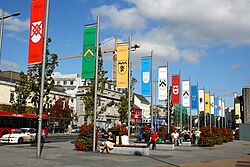 Eyre Square, Galway | |
| Location | |
| Location: | 53°16’19"N, 9°3’0"W |
| Data | |
| Population: | 75,529 |
| Dialling code: | 091 |
| Local Government | |
| Council: | City of Galway |
| Dáil constituency: |
Galway West |
| Website: | www.galwaycity.ie |
Galway is a port city and the county town of County Galway, a vast county which takes its name from the city.
Galway lies on the River Corrib between Lough Corrib and Galway Bay. It is reckoned the fourth most populous city in the Irish Republic.
Galway is considered the gateway to Connemara and the Gaeltacht, including Mám, An Teach Dóite, Cor na Móna, Ros Muc, Bearna and An Cheathrú Rua. The N59 along the western shore of Lough Corrib and the R337 along the northern shore of Galway Bay both lead to this largely rural and highly scenic region.
Name
The city takes its name from the river Gaillimh (River Corrib) that formed the western boundary of the earliest settlement, which was called Dún Bhun na Gaillimhe ("Fort at the mouth of the Gaillimh").[1] The word Gaillimh means "stony" as in "stony river", though mythical and alternative derivations are supplied by the romantic imagination. Historically, the name was given in English as Galliv,[2] which is closer to the Irish pronunciation, as is the city's name in Latin, Galvia.
The city has the nickname "The City of the Tribes" because "fourteen tribes" of merchant families[3] led the city in its Hiberno-Norman period. The term tribes was often a derogatory one in Cromwellian times. The merchants would have seen themselves as Irish gentry and loyal to the King. They later adopted the term as a badge of honour and pride in defiance of the town's Cromwellian garrison.
Civic tradition
The symbols of the office of the Mayor and the emblems of the dignity of the City Council are the Civic Sword (1620's) and the Great Mace (1710) which are carried in procession before the Mayor and Council on solemn civic occasions. When not in ceremonial use they can be seen at the Galway City Museum.
The highest honour the city can bestow is the Freedom of the City. Among the names on the Roll of Honour are: Douglas Hyde, President of Ireland, 1939; Eamonn de Valera, Taoiseach, 1946; Sean T O'Kelly, President of Ireland, 1950; Robert F Wagner, Mayor of New York, 1961; John F Kennedy, President of the United States, 1963; Pope John Paul II, 1979; Ronald Reagan, President of the United States, 1984; Hillary Rodham Clinton, 1999; Richard M. Daley, Mayor of Chigago, 2003; Ms Aung San Suu Kyi, Burmese campaigner, 2005; Ms Garry Hynes, Druid Theatre Founder, 2006 and Michael D. Higgins, President of Ireland, 2012.
History
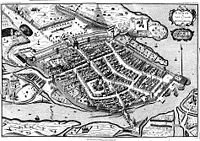
Dún Bhun na Gaillimhe ("Fort at the Mouth (bottom) of the Gaillimh") was built in 1124, by the King of Connaught, Tairrdelbach Ua Conchobair (1088–1156). Eventually, a small settlement grew up around this fort. During the Norman invasion of Connaught in the 1230s, Galway fort was captured by Richard Mor de Burgh, who had led the invasion. As the de Burghs eventually became Gaelicised, the merchants of the town, the Tribes of Galway, pushed for greater control over the walled city.
This led to their gaining complete control over the city and to the granting of mayoral status by the crown in December 1484. Galway endured difficult relations with its Irish neighbours. A notice over the west gate of the city, completed in 1562 by Mayor Thomas Óge Martyn, stated "From the Ferocious O'Flahertys may God protect us". A by-law forbade the native Irish (as opposed to Galway's Hiberno-Norman citizens) unrestricted access into Galway, saying "neither O’ nor Mac shall strutte nor swagger through the streets of Galway" without permission. During the Middle Ages, Galway was ruled by an oligarchy of fourteen[3] merchant families (12 of Norman origin and 2 of Irish origin). These were the "tribes" of Galway. The city thrived on international trade, and in the Middle Ages, it was the principal Irish port for trade with Spain and France. The most famous reminder of those days is ceann an bhalla ("the head of the wall"), now known as the Spanish Arch, constructed during the mayoralty of Wylliam Martin (1519–20). In 1477 Christopher Columbus visited Galway, possibly stopping off on a voyage to Iceland or the Faroe Islands. Seven or eight years later, he noted in the margin of his copy of Imago Mundi:
Men of Cathay have come from the west. [Of this] we have seen many signs. And especially in Galway in Ireland, a man and a woman, of extraordinary appearance, have come to land on two tree trunks [or timbers? or a boat made of such?]
The most likely explanation for these bodies is that they were Eskimos swept southward by the North Atlantic Current.[1]
During the 16th and 17th centuries Galway remained loyal to the English crown for the most part, even during the Gaelic resurgence, perhaps for reasons of survival. However, by 1642 the city had allied itself with the Catholic Confederation of Kilkenny during the Wars of the Three Kingdoms. During the resulting Cromwellian conquest of Ireland, Cromwellian forces captured the city after a nine-month siege. At the end of the 17th century the city supported the Jacobites in the Williamite war in Ireland and was captured by the Williamites after a very short siege not long after the Battle of Aughrim in 1691. The great families of Galway were ruined, and, having declined owing to the potato famines of 1845–1852, the city did not fully recover until the great economic bubble of the late twentieth century.
Culture
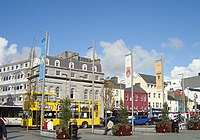
Galway is known as Ireland's Cultural Heart[4] and is renowned for its vibrant lifestyle and numerous festivals, celebrations and events.[5] Every July, Galway hosts the Galway Arts Festival which is known for its famous Macnas parade.
In 2004, there were three dance organisations, ten festival companies, two film organisations, two Irish language organisations, 23 musical organisations, twelve theatre companies, two visual arts groups, and four writers' groups based in the city.[6]
Furthermore, there were 51 venues for events, most of which were specialised for a certain field (e.g. concert venues or visual arts galleries), though ten were described as being 'multiple event' venues.[6] The main squares in the city are Eyre Square (containing John F Kennedy Park) in the centre of the city, and Spanish Parade next to the Spanish Arch.
In 2007, Galway was named as one of the eight "sexiest cities" in the world.[7] A 2008 poll ranked Galway as the 42nd best tourist destination in the world, or 14th in Europe and 2nd in Ireland (behind Dingle). It was ranked ahead of all European capitals except Edinburgh, and many traditional tourist destinations (such as Venice).[8]
Music
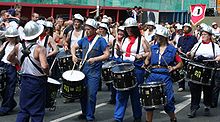
Galway has a vibrant and varied musical scene. As in most Irish cities traditional music is popular and is kept alive in pubs and by street performers. Notable bands from Galway include The Saw Doctors and The Stunning. Galway Early Music Festival presents European music from the 12th to the 18th century. It encourages not only music, but also dance and costumes. The festival involves both professional and amateur musicians.[9]
Galway Cathedral Recitals is an international series of concerts of classical music which has taken place in Galway Cathedral each July and August since 1994.[10]
A number of notable choirs are based in the city. They include Tribal Chamber Choir (founded in 2009) directed by Mark Keane;[11] the Galway Baroque Singers (founded in 1983) directed by Audrey Corbett; Cois Cladaigh Chamber Choir (founded in 1982) directed by Brendan O'Connor, which sang at the inauguration of President Michael D Higgins in St Patrick's Hall, Dublin Castle, on November 11, 2011; Galway Gospel Choir (founded in 2001) directed By Michel Durham Brandt; and Galway Choral Association (founded in 1998) directed by Norman Duffy.
The Galway Arts Festival (Féile Ealaíon na Gaillimhe) takes place in July. It was first held in 1978 and since then has grown into one of the biggest arts festivals in Ireland. It attracts international artists as well as providing a platform for local and national performers. The festival features parades, street performances and plays, musical concerts and comedy acts. Highlights of the festival tend to be performances by Macnas and Druid Theatre Company, two local performance groups. The Galway Youth Orchestra was formed in 1982.
The renowned folk and traditional singer Dolores Keane, lives in Galway.
The renowned performer and singer Siobhan McCormack currently resides in Galway with well known dancer Michael Flanagan.
Traditional Irish music
Galway city is a major centre for traditional Irish music. The traditional group De Dannan were based in Galway. Musicians such as Mickey Finn, Frankie Gavin, Johnny (Ringo) McDonagh and Alec Finn came to prominence in Galway. Carl Hession, a well known Irish composer, arranger and traditional musician also hails from Galway city.
[http://comhaltas.ie/ Comhaltas] branches operate in several parts of the city, teaching Irish Traditional Music to children. Dusty Banjos runs classes and sessions in the city for adults switching from other musical traditions to Irish Traditional Music, and for adult beginners and improvers who are not at a level where they could participate in general sessions.
Galway in literature
Gretta Conroy, in James Joyce's short story "The Dead", remembers her lover Michael Furey throwing stones against the window of her grandmother's house on Nun's Island, in the city.
Walter Macken's novel "Rain on the Wind" is set in the city as are the "Jack Taylor" crime novels of Ken Bruen.
The poem, "She Weeps Over Rahoon" by James Joyce, tells of the grief of Joyce's wife, Nora Barnacle, over the death of her onetime boyfriend Michael Feeney. Both he and Nora were from the city and Feeney is buried in Rahoon Cemetery in the western suburbs of the city.
Events and festivals
Many sporting, music, arts and other events take place in the city. The largest of these annual events include the Galway Arts Festival, the Galway Races, and the Galway International Oyster Festival. Other events include the Fleadh Imboilg,the Baboró International Children's Festival, the Cúirt International Festival of Literature, the Galway Early Music Festival,[12] Seachtain na Irish (March), Salthill Air Show (June), Little Havana Festival, the Galway Sessions,[13] Galway Garden Festival,[14] Galway Comedy Festival, Baffle Poetry Festival, Galway Aboo Halloween Festival, Tulca Festival of Visual Arts, Galway Science and Technology Festival, Spirit of Voice Festival, Galway Christmas Market,[15] Galway Film Fleadh,[16] Galway African Film Festival and Galway Pride Festival.[17] In 2009 Galway hosted a stopover on the Volvo Ocean Race and the city was finishing point of the round-the-world competition in July 2012. In June 2010, the Super8 Shots film festival was launched in Galway, the first Super 0 " (8 mm) film festival to occur in Ireland.[18] Among the festivals which take place within a 90-minute drive of the city are, Cruinniú na mBád (a Galway Hooker festival), held in Kinvara, the Cuckoo Festival, also held in Kinvara, the Ballinasloe Horse Fair (October), the Tuam Arts Festival (August), the Clarinbridge Oyster Festival, Féile na nOileáin, held in Leitir Mor, Conamara, Féile an Dóilín, held in An Ceathrú Rua, the Clifden Community Arts week and the Conamara Pony Show, held in Clifden, Mountbellew vintage show, each July.
Newspapers
- The Connacht Tribune
- The Connacht Sentinel
- The Connacht Tribune
- The Galway City Tribune
- The Galway Advertiser (free paper)
- The Galway Independent, prints on a Tuesday night for Wednesday circulation.
Places of interest

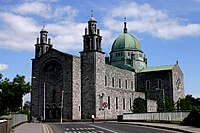
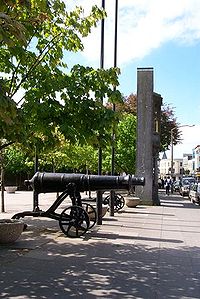
Lynch's Castle on Shop Street is probably the finest mediæval town house in Ireland. It is now a branch of Allied Irish Banks.
The Church of Ireland St Nicholas' Collegiate Church is the largest mediæval church still in everyday use in Ireland. It was founded in 1320 and enlarged in the following two centuries. It is a particularly pleasant building in the heart of the old city.
Amongst the city's limestone buildings is the Hotel Meyrick, originally the Railway Hotel and then the Great Southern Hotel, built by the Great Southern Railway Company in 1845.[19] Sitting at the southern perimeter of Eyre Square, it is the City's oldest hotel still in operation.
The Spanish Arch, in the south-west of the city, was built in the 1580s as an extension to the city walls, a part of which can be seen in the Corbett Court shopping centre.
In front of the Spanish Arch and opposite Jury's Hotel is a monument (see photograph at bottom of this article) to Christopher Columbus. It was presented to Galway by the city of Genoa in 1992 to commemorate both the 500th anniversary of the voyage to the New World and the visit of Columbus to Galway in 1477.
The remains of the Menlo Castle can be seen outside the city, on the Eastern bank of the River Corrib. It was one of the ancestral homes of the Blake family, one of the Tribes of Galway from c1600-1910. It is best viewed from the west bank at Dangan or the riverside walk at NUIG. The façade of the families townhouse (Blake's Castle) can be seen beside Jury's Hotel at the bottom of Quay Street.
The Eglinton Canal, named after a former Lord Lieutenant of Ireland, joins the River Corrib to the sea, and, flowing for just more than a kilometer, is a very pleasant walk from the University to the Claddagh.
The Claddagh is the oldest part of Galway but little or nothing remains of its old thatched village. However, in a side altar of the parish church, St Mary's on the Hill, is the late mediæval statue of Our Lady of Galway and visitors in mid-August can participate in the ancient ritual of the Blessing of the Bay, on the Sunday nearest the feast of the Assumption.
The Bowne doorway, originally located on Lower Abbeygate Street but now standing at the north end of Eyre Square, was the doorway to the townhouse of the Browne family, one of the fourteen Tribes of Galway.
The Lynch Window, (on Market Street), commemorates one of the city's most enduring legends. Here, in 1493, the Mayor, James Lynch FitzStephen, hanged his own son for the murder of Gomez, a young Spanish visitor who had the misfortune to befriend the Mayor's son. The son, mistaking friendship for love, stabbed the Spaniard to death in a fit of jealousy and dumped his body in the River Corrib. The Mayor was both Judge and Executioner in the case as nobody else would carry out the execution according to legend. This event is advanced as the origin of the phrase Lynching
Dillons Claddagh Gold on Quay Street are the original makers of the Claddagh Ring and are also Ireland's longest established jewelers, having been founded in 1750. The little museum attached to the premises holds the world's oldest examples of the Claddagh Ring.
The Hall of the Red Earl (Halla an Iarla Rua) can be viewed through a protective glass wall off Flood Street. It is the earliest mediæval settlement fragment surviving within the walls of the city. It was built in the 13th century and was a key municipal building for the collection of taxes, dispensation of justice and hosting banquets. It was the mediæval equivalent of tax office, court house and town hall.
Galway City has a fine collection of mainly early 17th century marriage stones which can be viewed throughout the city centre both inside buildings (as in the King's Head Pub) or on exterior lintels.
Galway Atlantaquaria which is also the National Aquarium of Ireland can be visited on The Promenade in the western suburb of Salthill.
Watching Atlantic salmon from the Salmon Weir Bridge (one of the bridges that spans the River Corrib) as they swim upstream to spawn is a popular pastime with both locals and tourists alike.
Theatre
Galway has a permanent Irish language theatre located in the city centre, Taibhdhearc na Gaillimhe, which has produced some of Ireland's most celebrated actors. The Druid Theatre Company has won international acclaim for its cutting edge production and direction.
There are many theatres in the city including Nun's Island Theatre, The Bank of Ireland Theatre, The Druid Lane Theatre, The Black Box Theatre and The Town Hall Theatre, a modern art theatre with two performance spaces opened in 1995[20] that has a 52-week program covering all aspects of the performing arts including ballets, musicals and operas. It has been the venue for many Irish film premieres, during the Galway Film Fleadh.
Economy
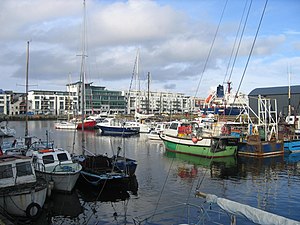
Galway City is the effective capital of Connaught. The city has experienced very rapid growth in recent years. Galway has a strong local economy with complementary business sectors, including manufacturing industry, tourism, retail and distribution, education, healthcare and services that include financial, construction, cultural, and professional.
Most (47%) of the people employed in Galway work in either the commerce or professional sector, with a large number (17%) also employed in manufacturing. Most industry and manufacturing in Galway, like the rest of Ireland, is hi-tech (e.g. ICT, medical equipment, electronics, chemicals, etc.), due to the Celtic Tiger economic boom, before the mighty crash. Tourism is also of major importance to the city, which had over 2.1 million visitors in 2000, and produced revenue of over €400 million.[21]
Waterways
The River Corrib is by far the most important waterway in Galway and a number of canals and channels were built above and through the city. The purposes of these to divert and control the water from the river, to harness its power and to provide a navigable route to the sea.[22] Of these, there were two major schemes – one between 1848 and 1858 and the other during the 1950s. The canals provided a power source for Galway and were the location of the first industries in the mid-19th century.
The Eglinton Canal provided a navigation from the sea (at the Claddagh Basin) to the navigable part of the river (above the Salmon Weir Bridge). Most of the mills are still used today for various purposes; for instance, NUI Galway still uses a water turbine for electricity generation for their building on Nun's Island.
Currently, there are four bridges across the Corrib. Following the southward flow of the river these are, from the north: the Quincentennial Bridge, the Salmon Weir Bridge, the William O'Brien Bridge and the Wolfe Tone Bridge. There are plans for a fifth bridge as part of the Galway City Outer Bypass project. The Clare River flows from the North of the County Galway, through Tuam, Claregalway into Lough Corrib.
Harbour
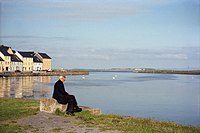
Galway is the most central port on the West Coast of Ireland in the sheltered eastern corner of Galway Bay. The harbour can be used by vessels up to 10,000 tons and the inner dock can accommodate up to 9 vessels at any one time. Pending approval, Galway Harbour may see major changes, should the €1.5 billion development plan go ahead.
Regular passenger ferry and freight services operate between Galway and the Aran Islands. The islands also have regular links with the towns of Rossaveal and Doolin, which are physically closer but far smaller.
Commuter ferry services have been proposed to the tourism town of Kinvara, on the opposite side of Galway Bay.
Major work in the harbour area was carried out in 2009 to accommodate the stopover of the Volvo Ocean Race. This was one of the biggest events ever to visit Galway. The event returned with the finale of the race in June 2012. This was unprecedented in Volvo Ocean Race history.
Outside links
| ("Wikimedia Commons" has material about Galway) |
- Athenry History Archive, Galway
- Galway City Council (local authority)
- Galway Public Transport Website
- Galway History Website
- Galway Tour Guides
References
- ↑ 1.0 1.1 David B. Quinn "Columbus and the North: England, Iceland, and Ireland", The William and Mary Quarterly, Third Series, Vol 49, No. 2 (Apr., 1992), pp. 278–297
- ↑ Kavanagh, Mary. Galway-Gaillimh: a bibliography of the city and county. Galway County Council, 2000.
- ↑ 3.0 3.1 They were the merchant families of Athy, Blake, Bodkin, Browne, Darcy, Deane, Font, Ffrench, Joyce, Kirwin, Lynch, Martyn, Morris, Skerrett.
- ↑ "Education Ireland". Educationireland.ie. http://www.educationireland.ie/index.php?option=com_content&task=view&id=185&Itemid=199. Retrieved 12 August 2010.
- ↑ Tourism Ireland, Galway Festivals
- ↑ 6.0 6.1 "Atlas 2004 – Section 1" (PDF). http://www.galwaycity.ie/AllServices/CityDevelopmentBoard/ProjectsandSchemes/GalwayCityAtlas2004/FileEnglish,671,en.pdf. Retrieved 12 August 2010.
- ↑ MSN Travel UK – 2007's Sexiest Cities
- ↑ "2008 Travellers' Choice Destination Awards" (PDF). http://cdn.tripadvisor.com/pdfs/tca/TCDestinationsAwards2008.pdf. Retrieved 12 August 2010.
- ↑ "Galway Early Music website". Galwayearlymusic.com. 16 March 2000. http://www.galwayearlymusic.com. Retrieved 12 August 2010.
- ↑ "Galway Cathedral Recitals website". Recitals.galwaycathedral.ie. http://recitals.galwaycathedral.ie. Retrieved 12 August 2010.
- ↑ http://www.tribalchamberchoir.com
- ↑ Galwayearlymusic.com
- ↑ Galwaysessions.com
- ↑ GalwayGardenFestival.com
- ↑ Galwaychristmasmarket.ie
- ↑ Galwayfilmfleadh.com
- ↑ Galwaycumunitypride.com
- ↑ The first Super 8 picture show, Irish Times, 19 June 2010
- ↑ "Hotel Meyrick – About". Greatsouthernhotelgalway.com. http://www.greatsouthernhotelgalway.com/. Retrieved 12 August 2010.
- ↑ "About the town hall / its history and more". Tht.ie. http://www.tht.ie/?id=about. Retrieved 12 August 2010.
- ↑ "Galway City Development Board – Galway at the Beginning of the 21st century" (PDF). http://www.galwaycity.ie/AllServices/CityDevelopmentBoard/Strategy2002-2012/TheFile,427,en.pdf. Retrieved 12 August 2010.
- ↑ "Waterways of Galway; – Galway Guide". Galway.net. http://www.galway.net/galwayguide/history/waterways/. Retrieved 12 August 2010.
| Cities in the Republic of Ireland |
|---|
